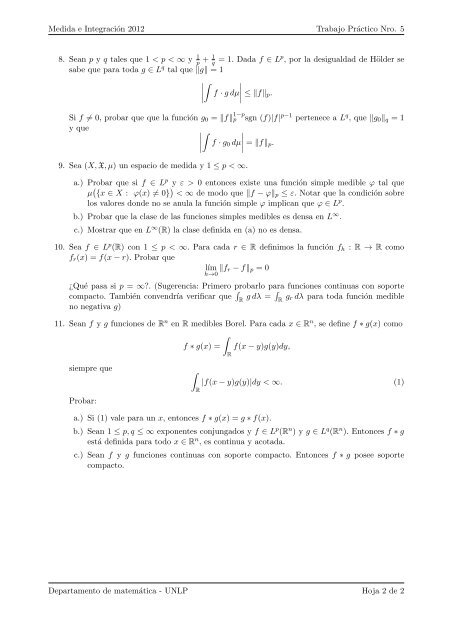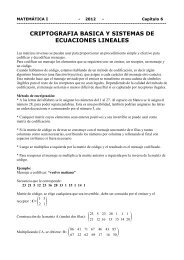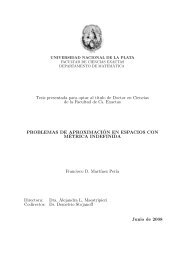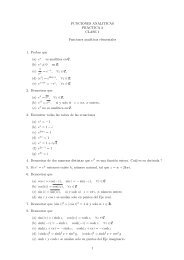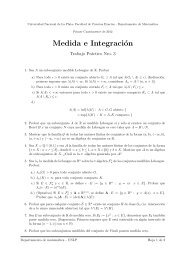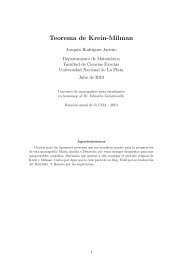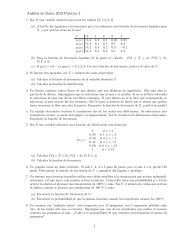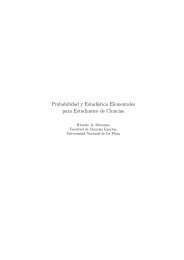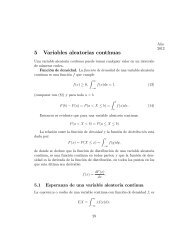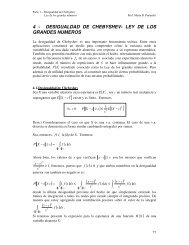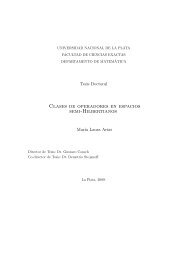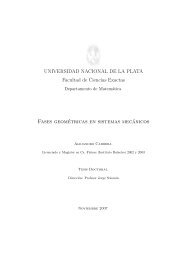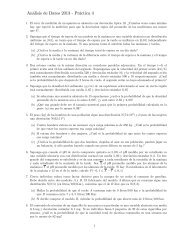Medida e Integración - Departamento de Matemática - Universidad ...
Medida e Integración - Departamento de Matemática - Universidad ...
Medida e Integración - Departamento de Matemática - Universidad ...
You also want an ePaper? Increase the reach of your titles
YUMPU automatically turns print PDFs into web optimized ePapers that Google loves.
<strong>Medida</strong> e <strong>Integración</strong> 2012 Trabajo Práctico Nro. 5<br />
8. Sean p y q tales que 1 < p < ∞ y 1 1<br />
p + q = 1. Dada f ∈ Lp , por la <strong>de</strong>sigualdad <strong>de</strong> Höl<strong>de</strong>r se<br />
sabe que para toda g ∈ Lq tal que g = 1<br />
<br />
<br />
<br />
<br />
f · g dµ <br />
≤ fp.<br />
Si f = 0, probar que que la función g0 = f 1−p<br />
p sgn (f)|f| p−1 pertenece a Lq , que g0q = 1<br />
y que <br />
<br />
<br />
f · g0 dµ <br />
= fp.<br />
9. Sea (X, X, µ) un espacio <strong>de</strong> medida y 1 ≤ p < ∞.<br />
a.) Probar que si f ∈ L p y ε > 0 entonces existe una función simple medible ϕ tal que<br />
µ {x ∈ X : ϕ(x) = 0} < ∞ <strong>de</strong> modo que f − ϕp ≤ ε. Notar que la condición sobre<br />
los valores don<strong>de</strong> no se anula la función simple ϕ implican que ϕ ∈ L p .<br />
b.) Probar que la clase <strong>de</strong> las funciones simples medibles es <strong>de</strong>nsa en L ∞ .<br />
c.) Mostrar que en L ∞ (R) la clase <strong>de</strong>finida en (a) no es <strong>de</strong>nsa.<br />
10. Sea f ∈ L p (R) con 1 ≤ p < ∞. Para cada r ∈ R <strong>de</strong>finimos la función fh : R → R como<br />
fr(x) = f(x − r). Probar que<br />
lím<br />
h→0 fr − fp = 0<br />
¿Qué pasa si p = ∞?. (Sugerencia: Primero probarlo para funciones continuas con soporte<br />
compacto. También convendría verificar que <br />
R g dλ = R gr dλ para toda función medible<br />
no negativa g)<br />
11. Sean f y g funciones <strong>de</strong> Rn en R medibles Borel. Para cada x ∈ Rn , se <strong>de</strong>fine f ∗ g(x) como<br />
<br />
f ∗ g(x) = f(x − y)g(y)dy,<br />
R<br />
siempre que <br />
|f(x − y)g(y)|dy < ∞. (1)<br />
R<br />
Probar:<br />
a.) Si (1) vale para un x, entonces f ∗ g(x) = g ∗ f(x).<br />
b.) Sean 1 ≤ p, q ≤ ∞ exponentes conjungados y f ∈ L p (R n ) y g ∈ L q (R n ). Entonces f ∗ g<br />
está <strong>de</strong>finida para todo x ∈ R n , es continua y acotada.<br />
c.) Sean f y g funciones continuas con soporte compacto. Entonces f ∗ g posee soporte<br />
compacto.<br />
<strong>Departamento</strong> <strong>de</strong> matemática - UNLP Hoja 2 <strong>de</strong> 2


